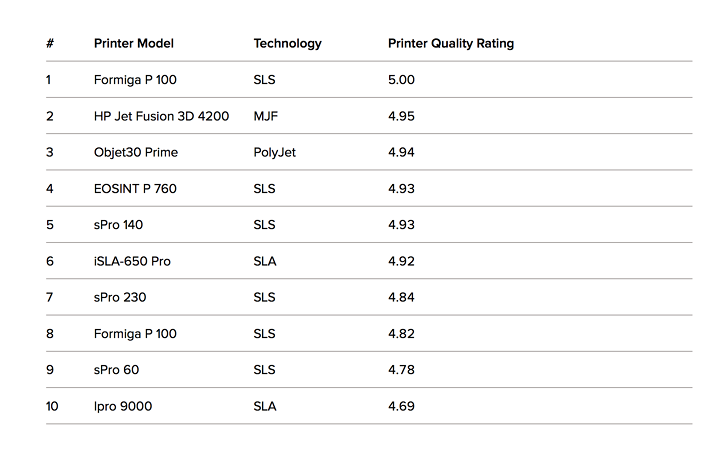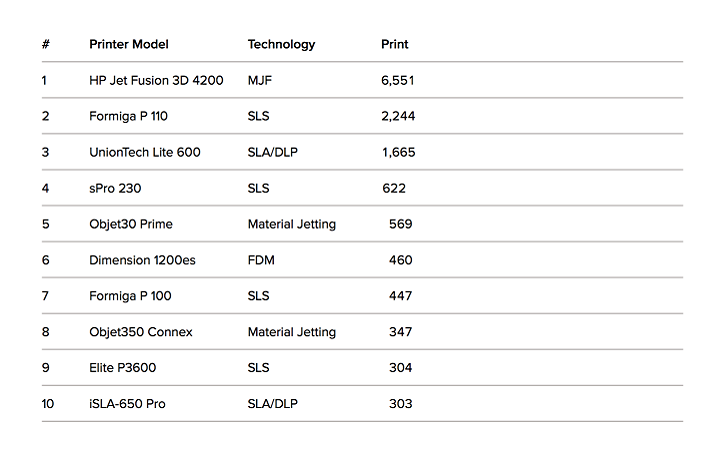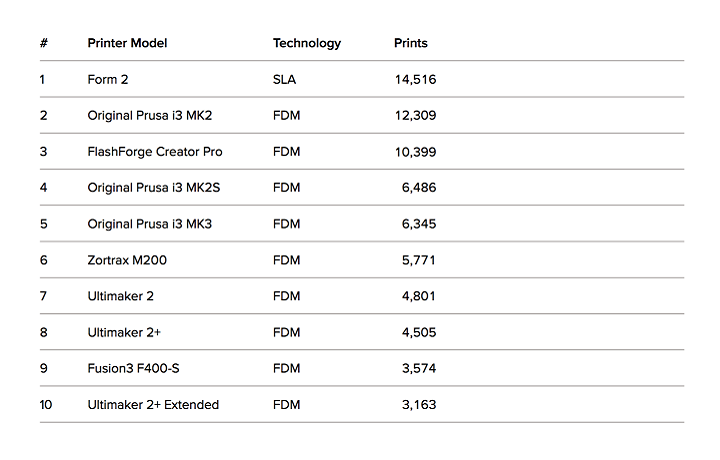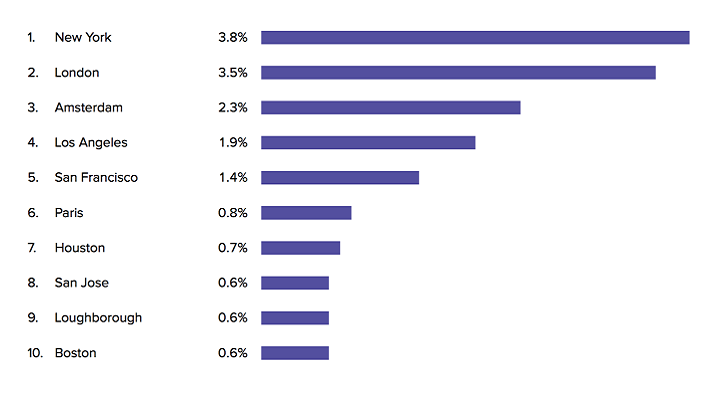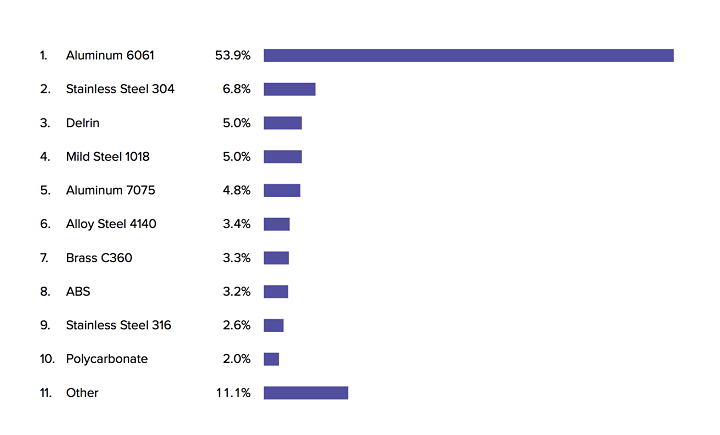 Last quarter, 3D Hubs published its first Trends report to include Digital Manufacturing trends. The popular and long-running report still includes all of the latest information about 3D printing, but now also includes more insights on other digital manufacturing technologies, such as injection molding and CNC machining.
Last quarter, 3D Hubs published its first Trends report to include Digital Manufacturing trends. The popular and long-running report still includes all of the latest information about 3D printing, but now also includes more insights on other digital manufacturing technologies, such as injection molding and CNC machining.
Today, 3D Hubs has released the second edition of this newly revamped report. The Digital Manufacturing Trends report for Q3/2018 is exclusively available for free download here.
“Spring has brought about a change to the data, with the end of the financial year and students ordering,” George Fisher-Willson, 3D Hubs’ Communications Manager, told 3DPrint.com.
In the Highest Rated Industrial Printers category, SLS still reigns supreme, accounting for six of the top ten 3D printer models, though one should note that only 3D printers with over 30 reviews per quarter are included in the breakdown. The top four are virtually unchanged from last quarter, with the Formiga P 100 still in first with a quality rating of 5. The iSLA-650 Pro was knocked down one slot to sixth place by the sPro 140, which received the same 4.93 rating as the EOSINT P 760 above it.
The HP Jet Fusion 3D 4200 is holding steady at first place in the Most Used Industrial Printers category…and with a record 30% more output, with an increase from 5,087 to over 6,550 prints.
“At #1 the HP machine created 6,551 prints, nearly triple that of #2 place Formiga P 110 which achieved a respectable 2,244,” 3D Hubs’ Digital Manufacturing Trends report states.
The large-format UnionTech Lite 600, up from 201 to 1,665 prints, most often used to create automotive molds and tooling, moves from its tenth place ranking last quarter to third this time around, knocking the sPro 230 down to fourth. The Objet30 Prime is also up a few places this time to round out the top five, though its number of prints only increased by 227.
In terms of Highest Rated Desktop Printers, only 3D printers with over 140 reviews in the quarter are included in the statistics for this quarter, which have the Zortrax M200 moving up from fifth place last quarter with a rating of 4.81 to first place this time around with a barely increased rate of 4.87.
The LulzBot Taz 5 makes a surprise entrance, and its 4.86 rating puts it at #2 on the list. Those reviews must have all been extremely positive, as #3 on the list, the Original Prusa i3 MK2, has the exact same rating with a total of 658 reviews. The Creality CR-10 is up from the tenth position to #4, and the Original Prusa i3 MK3 is up to #5 this quarter, with 349 reviews netting it a 4.83 rating.
The report notes, “The machines also took a large share of the reviews showing their popularity with service providers across the world.”
The battle rages on between the Form 2 and the Original Prusa i3 MK2 in the Most Used Desktop Printers category, with the Form 2 increasing its number of prints from 14,211 to 14,516 to jump back up to first. This gap may continue to grow, as Formlabs has released two new resins over the last few months. The FlashForge Creator Pro and the Original Prusa i3 MK2S both remain, respectively, in the #3 and 4 slots, though the latter has dropped its number of prints just a smidge, and the Prusa i3 MK3 has made the list this quarter, with a total of 6,345 prints.
According to the report, “Of the total 71,869 prints produced in the top 10, the Prusa machines have manufactured over 25,000 of the [sic], an impressive figure.”
Not much change this quarter for the Most Used Technologies, as FDM 3D printing continues its first place ranking…even going up one percentage point while SLS dropped one.
“For the first time since the report began Metal Sintering double its share going to 2%, this could be potentially due to businesses putting in their high-end orders before the end of the financial year,” the report stated. “It could also be down the fact that Metal 3D printing is seeing further adoption by large multinationals as its ability to create complex geometries in metal cannot be beaten by traditional technologies.”
Last quarter, the Most Used Materials category adopted the generic term “Standard,” to denote that suppliers are listing materials to include all variants. Since then, the top ten has changed a little bit.
“Standard PLA has distanced itself further from ABS, at #1 with 33%, growing 3% since Q2’s report. ABS, although it maintains its #2 spot with 14%, has seen its number go the opposite way with a decrease of 3%,” the report explained. “This movement could be down to more new materials entering the market that challenge ABS’s position, which is relatively hard to print and not safe for non-ventilated spaces due to its fumes.”
Standard Resin is now in the #3 spot with 9% usage, while SLS Nylon appears for the first time at #4 with 8% usage. Standard PETG is hanging on to the #5 spot, though its reported usage has increased from 4% to 6%. Onyx, the proprietary material from Markforged that contains chopped Carbon Fiber, has entered the list for the first time at #9.
As for FDM Color Distribution, black is still in the #1 spot, with an increase of 5% of the market share – according to the report, nearly half of all of the 3D printed parts made on 3D Hubs are black. However, only the colors of submitted prints are reviewed for this report, so who’s to say that gray, up to #3 this quarter, isn’t used more often and those people just don’t submit their work?
Additionally, the spread of colors has dropped quite a bit, with Other down to 11% from 24%, which “is in line with the standardization of colors on 3D Hubs” explained last quarter. Transparent also makes it to the list for the first time, which 3D Hubs speculates could be due to the rising popularity of SLA and DLP 3D printing.
“The student peak in line with the end of the financial year has impacted the Top Print Cities and Top Print Countries,” Fisher-Wilson tells us. “Both the USA/UK and New York/London grew substantially, as the high concentration of universities in these cities bumped up their market share.”
Loughborough University, which 3D Hubs is familiar with, has also cracked the top ten for the first time in terms of Top Print Cities with its #9 placement. Following New York and London in the top two places, Amsterdam, Los Angeles, and San Francisco round out the rest of the top five.
The US and the UK continue to hold the top two spots for 3D printing usage in the Top Print Countries list, but the Netherlands has come up to knock Canada out of third place down to fifth, while Germany sits in fourth.
The report says, “India moves into the Top 10 for the first time, sharing the same percentage as Italy with 1.4% at #10. With the increases for the top two, countries like France have seen a substantial drop in market share moving from 3.4% to 2.5%. The trend continues that countries with a heavy population of students have seen market share increase.”
In Most Used CNC Materials, affordable Aluminum 6061 is still hanging on to the lead, with over half of all 3D Hubs’ orders using the materials, though its usage has decreased a few percentage points. However, as Fisher-Wilson tells us, there was a shake-up in the category as previously predicted, with 19 new materials added this quarter.
“Stainless Steel 304 at #2 lost nearly half of its market share (11.6% to 6.8%) with Delrin at #3 and Mild Steel 1018 at #4 debuting with 5% each,” Fisher-Wilson told 3DPrint.com.
Aluminum 7075, with 4.8% usage, is #5 in this category.
There’s now more variety in Most Used Finishes at 3D Hubs, as it’s introduced some new materials, though the percentage of respondents leaving their parts as machined is down a bit from 77.6% to 70.8%. Bead blasting, at 7.5% in the #2, is still far behind, though the number three finish, anodized color, has increased its usage by nearly double.
What do you think of these results? Discuss this new trend report, and other 3D printing topics, at 3DPrintBoard.com, or share your thoughts in the Facebook comments below.
Subscribe to Our Email Newsletter
Stay up-to-date on all the latest news from the 3D printing industry and receive information and offers from third party vendors.
You May Also Like
Further Understanding of 3D Printing Design at ADDITIV Design World
ADDITIV is back once again! This time, the virtual platform for additive manufacturing will be holding the first-ever edition of ADDITIV Design World on May 23rd from 9:00 AM –...
3D Printer Maker EVO-tech Reborn as NEVO3D — Once More With Feeling
EVO-tech was a 3D printing service and original equipment manufacturer established in 2013 and based in Schörfling am Attersee, Austria. The company produced high-quality material extrusion systems featuring linear bearings,...
3D Systems Brings 3D Printed PEEK Cranial Implant to the U.S. with FDA Clearance
For more than 10 years, 3D Systems (NYSE:DDD) has worked hand-in-hand with surgeons to plan over 150,000 patient-specific cases, and develop more than two million instruments and implants from its...
CDFAM Returns to Berlin for Second Annual Symposium
The second CDFAM Computational Design Symposium is scheduled for May 7-8, 2024, in Berlin, and will convene leading experts in computational design across all scales. Building upon the first event...


